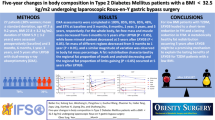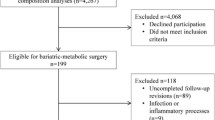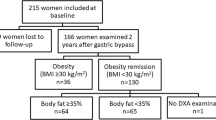Abstract
Background
Type 2 diabetes mellitus (T2DM) with central obesity is a common clinical presentation in Chinese patients. Body mass index (BMI) is a criterion determining central obesity that, when combined with dual-energy X-ray absorptiometry (DXA), accurately reflects body composition and fat mass distribution. The utility of DXA-derived measures in the evaluation of metabolic surgery still needs to be investigated.
Methods
In this cohort study, 78 Chinese patients with central obesity (WC ≥ 90 cm for males, WC ≥ 85 cm for females) or BMI above 27.5 kg/m2 underwent gastric bypass between October 2010 and October 2012. The patients were followed for 12 months. Preoperative, perioperative, and postoperative metabolic parameters and DXA results were prospectively collected and analyzed.
Results
A total of 57 of 78 cases (73.1%) were diagnosed with central obesity. There was a significant decrease in BMI, WC, and WHR at each point in time (P < 0.05), with fasting plasma glucose (FPG), fasting insulin secretion (FINS), and the homeostasis model assessment of insulin resistance index (HOMA-IR) also significantly improved. Body fat mass percentage (%BF) results showed significant decreases in different regions. %BF regions, except for trunk region %BF, were significantly correlated with BMI and WC (P < 0.01). Pearson correlation coefficients of 0.562 and 0.577 were evident between BMI and total %BF, and android %BF and WC, respectively. Linear regression analysis was conducted to assess the linear relationship between BMI and %BF, and android %BF, WC, and WHR; linear formulas were derived.
Conclusions
%BF is a more significant predictor of obesity, with BMI significantly underestimating visceral adipose tissue (VAT). In addition to BMI, total %BF and android %BF have clinical utility as indicators for metabolic surgery evaluation as well as patient selection.
Similar content being viewed by others
Abbreviations
- T2DM:
-
Type 2 diabetes mellitus
- DXA:
-
Dual-energy X-ray absorptiometry
- WC:
-
Waist circumference
- BMI:
-
Body mass index
- WHR:
-
Waist-hip ratio
- FPG:
-
Fasting plasma glucose
- FINS:
-
Fasting insulin
- HOMA-IR:
-
Homeostasis model assessment of insulin resistance index
- %BF:
-
Body fat mass percentage
- VAT:
-
Visceral adipose tissue
- MS:
-
Metabolic surgery
- LRYGB:
-
Laparoscopic Rou-en-Y gastric bypass
References
Collaboration NCDRF. Trends in adult body-mass index in 200 countries from 1975 to 2014: a pooled analysis of 1698 population-based measurement studies with 19.2 million participants. Lancet. 2016;387:1377–96.
Bays HE, Laferrere B, Dixon J, et al. Adiposopathy and bariatric surgery: is ‘sick fat’ a surgical disease? Int J Clin Pract. 2009;63:1285–300.
Alberti KG, Zimmet P, Shaw J, et al. The metabolic syndrome--a new worldwide definition. Lancet. 2005;366:1059–62.
Yang W, Lu J, Weng J, et al. Prevalence of diabetes among men and women in China. N Engl J Med. 2010;362:1090–101.
Rubino F, Nathan DM, Eckel RH, et al. Metabolic surgery in the treatment algorithm for type 2 diabetes: a joint statement by international diabetes organizations. Surg Obes Relat Dis. 2016;12:1144–62.
Mechanick JI, Youdim A, Jones DB, et al. Clinical practice guidelines for the perioperative nutritional, metabolic, and nonsurgical support of the bariatric surgery patient--2013 update: cosponsored by American Association of Clinical Endocrinologists, the Obesity Society, and American Society for Metabolic & Bariatric Surgery. Surg Obes Relat Dis. 2013;9:159–91.
Chinese Society for Metabolic and Bariatric Surgery. Guidelines for surgical treatment of obesity and type 2 diabetes mellitus in China (2014). Chin J Pract Surg. 2014;34:1005–10.
Lear SA, Humphries KH, Kohli S, et al. Visceral adipose tissue accumulation differs according to ethnic background: results of the Multicultural Community Health Assessment Trial (M-CHAT). Am J Clin Nutr. 2007;86:353–9.
He Y, Zhai F, Ma G, et al. Abdominal obesity and the prevalence of diabetes and intermediate hyperglycaemia in Chinese adults. Public Health Nutr. 2009;12:1078–84.
Wat NM, Lam TH, Janus ED, et al. Central obesity predicts the worsening of glycemia in southern Chinese. Int J Obes Relat Metab Disord. 2001;25:1789–93.
Chen CM. Overview of obesity in mainland China. Obes Rev. 2008;9(Suppl 1):14–21.
Alberti KG, Zimmet PZ. Definition, diagnosis and classification of diabetes mellitus and its complications. Part 1: diagnosis and classification of diabetes mellitus provisional report of a WHO consultation. Diabet Med. 1998;15:539–53.
Wang G, Zhu L, Li W, et al. Can low BMI Chinese patients with type 2 diabetes benefit from laparoscopic Roux-en-Y gastric bypass surgery? Surg Obes Relat Dis. 2016;12:1890–6.
Zhu L, Mo Z, Yang X, et al. Effect of laparoscopic Roux-en-Y gastroenterostomy with BMI<35 kg/m(2) in type 2 diabetes mellitus. Obes Surg. 2012;22:1562–7.
Consultation WHOE. Appropriate body-mass index for Asian populations and its implications for policy and intervention strategies. Lancet. 2004;363:157–63.
Peltz G, Aguirre MT, Sanderson M, et al. The role of fat mass index in determining obesity. Am J Hum Biol. 2010;22:639–47.
Romero-Corral A, Somers VK, Sierra-Johnson J, et al. Accuracy of body mass index in diagnosing obesity in the adult general population. Int J Obes. 2008;32:959–66.
Gasier HG, Hughes LM, Young CR, et al. Comparison of body composition assessed by dual-energy X-ray absorptiometry and BMI in current and former U.S. Navy service members. PLoS One. 2015;10:e0132157.
Lakdawala M, Bhasker A. Report: Asian Consensus Meeting on Metabolic Surgery. Recommendations for the use of bariatric and gastrointestinal metabolic surgery for treatment of obesity and type II diabetes mellitus in the Asian population: August 9th and 10th, 2008, Trivandrum, India. Obes Surg. 2010;20:929–36.
Janssen I, Shields M, Craig CL, et al. Prevalence and secular changes in abdominal obesity in Canadian adolescents and adults, 1981 to 2007-2009. Obes Rev. 2011;12:397–405.
Flegal KM, Shepherd JA, Looker AC, et al. Comparisons of percentage body fat, body mass index, waist circumference, and waist-stature ratio in adults. Am J Clin Nutr. 2009;89:500–8.
Liu Y, Xiong J, He H, et al. Visfatin level after laparoscopic Roux-en-Y gastric bypass surgery in patients with type 2 diabetes. Zhong Nan Da Xue Xue Bao Yi Xue Ban. 2013;38:258–61.
Zhang H, Han X, Yu H, et al. Effect of Roux-en-Y gastric bypass on remission of T2D: medium-term follow-up in Chinese patients with different BMI obesity class. Obes Surg. 2017;27:134–42.
Rothney MP, Xia Y, Wacker WK, et al. Precision of a new tool to measure visceral adipose tissue (VAT) using dual-energy X-ray absorptiometry (DXA). Obesity (Silver Spring). 2013;21:E134–6.
Bazzocchi A, Diano D, Vicennati V, et al. Relationships between total and regional adiposity and epicardial fat in obese women: how can dual-energy X-ray absorptiometry be associated with echocardiographic epicardial fat measurements? Clin Obes. 2013;3:132–40.
Yu H, Di J, Bao Y, et al. Visceral fat area as a new predictor of short-term diabetes remission after Roux-en-Y gastric bypass surgery in Chinese patients with a body mass index less than 35 kg/m2. Surg Obes Relat Dis. 2015;11:6–11.
Palazuelos-Genis T, Mosti M, Sanchez-Leenheer S, et al. Weight loss and body composition during the first postoperative year of a laparoscopic Roux-en-Y gastric bypass. Obes Surg. 2008;18:1–4.
Schneider J, Peterli R, Gass M, et al. Laparoscopic sleeve gastrectomy and Roux-en-Y gastric bypass lead to equal changes in body composition and energy metabolism 17 months postoperatively: a prospective randomized trial. Surg Obes Relat Dis. 2016;12:563–70.
Huettner F, Rammos CK, Dynda DI, et al. Body composition analysis in bariatric surgery: use of air displacement plethysmograph. Am Surg. 2012;78:698–701.
Jia WP, Lu JX, Xiang KS, et al. Prediction of abdominal visceral obesity from body mass index, waist circumference and waist-hip ratio in Chinese adults: receiver operating characteristic curves analysis. Biomed Environ Sci. 2003;16:206–11.
Li W, Zhu L, Mo Z, et al. Effect of laparoscopic Roux-en-Y gastric bypass on body composition and insulin resistance in Chinese patients with type 2 diabetes mellitus. Obes Surg. 2014;24:578–83.
Ng AC, Wai DC, Tai ES, et al. Visceral adipose tissue, but not waist circumference is a better measure of metabolic risk in Singaporean Chinese and Indian men. Nutr Diabetes. 2012;2:e38.
Bhasker AG, Dixon JB, Lakdawala M. Selection of bypass vs sleeve for the management of type-2 diabetes in severely obese: could ethnicity play a role? Obes Surg. 2018 Oct;28(10):3073–9.
Funding
The paper was supported by the National Natural Science Foundation of China (81600431) and the Natural Science Foundation of Hunan Province of China (2017JJ3471).
Author information
Authors and Affiliations
Corresponding author
Ethics declarations
Consent was obtained from all participants before the start of the study, which was conducted in compliance with the protocol approved by the Ethics Committee of our hospital.
Conflict of Interest
The authors declare that they have no conflict of interest.
Additional information
Publisher’s Note
Springer Nature remains neutral with regard to jurisdictional claims in published maps and institutional affiliations.
Rights and permissions
About this article
Cite this article
Li, P., Ji, G., Li, W. et al. The Relationship Between BMI, Body Composition, and Fat Mass Distribution in Rou-en-Y Gastric Bypass Patients. OBES SURG 30, 1385–1391 (2020). https://doi.org/10.1007/s11695-019-04300-w
Published:
Issue Date:
DOI: https://doi.org/10.1007/s11695-019-04300-w




